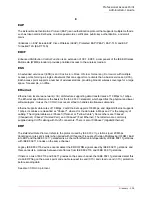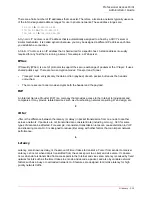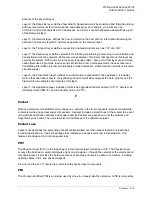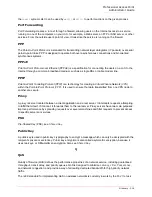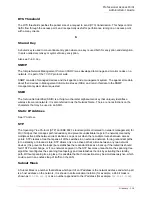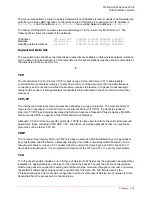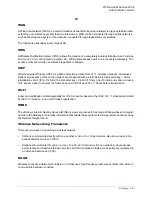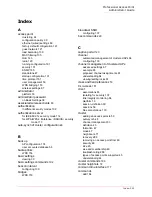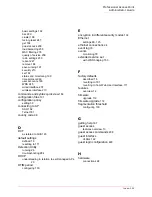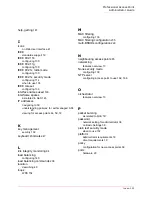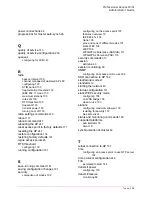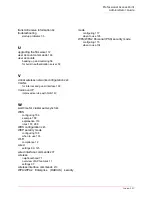
Professional Access Point
Administrator Guide
Glossary - 320
U
UDP
The
User Datagram Protocol
(UDP) is a transport layer protocol providing simple but unreliable datagram
services. It adds port address information and a checksum to an
IP
packet.
UDP neither guarantees delivery nor does it require a connection. It is lightweight and efficient. All error
processing and retransmission must be performed by the application program.
Unicast
A
Unicast
sends a message to a single, specified receiver. In wireless networks, unicast usually refers to
an interaction in which the access point sends data traffic in the form of
IEEE
802.1x
Frame
s directly to a
single client station
MAC
address on the network.
Some wireless security modes distinguish between how unicast, multicast, and broadcast frames are
encrypted or whether they are encrypted.
See also
Multicast
and
Broadcast
.
URL
A
Uniform Resource Locator
(URL) is a standard for specifying the location of objects on the Internet, such
as a file or a newsgroup. URLs are used extensively in HTML documents to specify the target of a
hyperlink which is often another HTML document (possibly stored on another computer). The first part of
the URL indicates what protocol to use and the second part specifies the IP address or the domain name
where that resource is located.
For example,
ftp://ftp.usr.com/downloads/myfile.tar.gz
specifies a file that should be fetched
using the FTP protocol;
http://www.usr.com/index.html
specifies a Web page that should be fetched
using the
HTTP
protocol.
V
VLAN
A
virtual
LAN
(VLAN) is a software-based, logical grouping of devices on a network that allow them to act
as if they are connected to a single physical network, even though they may not be. The nodes in a VLAN
share resources and bandwidth, and are isolated on that network. The Professional Access Point supports
the configuration of a wireless VLAN. This technology is used on the access point for the virtual guest
network feature.
VPN
A
Virtual Private Network
(VPN) is a network that uses the Internet to connect its nodes. It uses encryption
and other mechanisms to ensure that only authorized users can access its nodes and that data cannot be
intercepted.
Summary of Contents for Instant802 APSDK
Page 1: ...Professional Access Point Administrator Guide R46 1224 00 rev 2 0 07 06...
Page 2: ......
Page 4: ...Professional Access Point Administrator Guide iv...
Page 8: ...Professional Access Point Administrator Guide viii...
Page 42: ...Professional Access Point Administrator Guide Basic Settings 42...
Page 52: ...Professional Access Point Administrator Guide Access Points 52...
Page 58: ...Professional Access Point Administrator Guide User Management 58...
Page 62: ...Professional Access Point Administrator Guide Sessions 62...
Page 70: ...Professional Access Point Administrator Guide Channel Management 70...
Page 88: ...Professional Access Point Administrator Guide Neighboring Access Points 88...
Page 96: ...Professional Access Point Administrator Guide Ethernet Wired Settings 96...
Page 120: ...Professional Access Point Administrator Guide Security 120...
Page 128: ...Professional Access Point Administrator Guide Virtual Wireless Networks 128...
Page 134: ...Professional Access Point Administrator Guide Radio 134...
Page 138: ...Professional Access Point Administrator Guide MAC Filtering 138...
Page 152: ...Professional Access Point Administrator Guide Quality of Service 152...
Page 160: ...Professional Access Point Administrator Guide Wireless Distribution System 160...
Page 164: ...Professional Access Point Administrator Guide Time Protocol 164...
Page 170: ...Professional Access Point Administrator Guide SNMP 170...
Page 290: ...Professional Access Point Administrator Guide Configuration Troubleshooting 290...
Page 298: ...Professional Access Point Administrator Guide Regulatory Information 298...
Page 328: ...Professional Access Point Administrator Guide Index 328...




